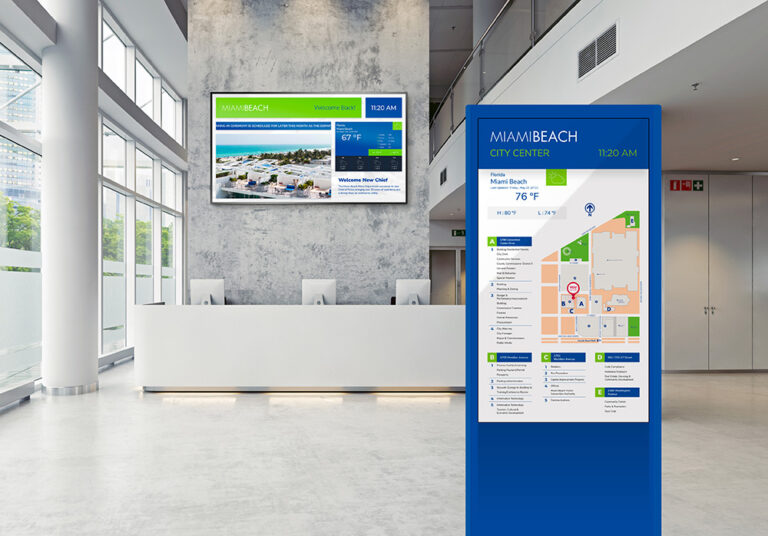Digital Signage for Small Businesses: Integration for your Business
As more businesses adopt digital signage, the market will grow by approximately 16.1% by 2030. Therefore, small business owners should take advantage of this opportunity. Usually, small businesses refrain from new technologies since they assume the technology will be complex. Worse, they dread the additional expense of hiring an expert and purchasing the tool.
However, with digital signage, small business owners don’t have to worry about increased costs due to this technology. Moreover, since information changes rapidly, print media cannot be a business’s primary form of communication.
Small businesses can now join in this new trend due to the ease of acquisition of digital signage. Besides, the benefits of digital signage align with each enterprise’s desire to grow and expand its reach.
You can enjoy faster and real-time communication, increased user interactivity, wayfinding technologies, and many more benefits in your enterprise. Read on to discover how to integrate digital signage into your operations.

1. Digital Signage Displays
Digital signage displays determine the output quality you give your readers. Quality output grabs your readers’ attention and keeps them engaged while communicating with them. Therefore, you want to select your business digital signage displays carefully.
Usually, commercial-grade LCD and LED screens are suitable as digital signs compared to consumer-grade displays. Measure the size of your digital sign placement areas to ensure you purchase the right size. Consider the various displays you want, for instance, iPads, touchscreens, video walls, or digital kiosks.
Also, watch out for your screen’s resolution, weight, durability, and HDMI ports during purchase. The monitors’ pricing varies to give you affordable options. You must ensure you receive a warranty for your display in case of any technical issues.
Digital signage displays also allow interactivity. Depending on your business, you want to incorporate interactive displays such as touchscreens that allow input from your users. Your lobby signage kiosks and conference room digital signs are appropriate places for touchscreens. This way, navigation, and room booking will be easier for your clients and employees.
2. Digital Signage Media Player
A media player transmits content from the digital signage software to your digital signs. The media player maintains the correct aspect ratio, audio and video synchronization, and playback speed. Therefore, you need to choose the correct media player for your signage.
Media players are available in different forms. Some resemble routers, some USB sticks or modems, while others are in-built chips. Therefore, a media player can be built-in or external. Built-in players are located within your display and include the Samsung Tizen, common in commercial screens. Android tablets will also have in-built media players.
Unlike built-in players, you need to plug-in external media players to the screen through the HDMI ports. Examples of external media players are the android media players and the Amazon fire TV stick. Small business digital signage users with small networks can use the Raspberry pi media player for their projects.
Look at the media players’ security, high-quality playback, open source, and ability to support multiple content formats. An appropriate digital signage player will ensure the efficient transmission of information from the software to the screen.
3. Digital Signage Software
The digital signage software you select will determine the effectiveness of the business digital signage platform. Digital signage software is also known as content management software (CMS). The software serves as the back end of the digital signage solutions where you develop and upload your content.
However, since numerous CMS providers are available, you should know the essential elements of your digital signage software. This way, you will know what to look for when acquiring content management software.
Ensure you acquire cloud-based digital signage software. Traditionally, users installed the software on a laptop or desktop. Therefore, to display content on the screen, they would copy it to the screen through USB drives. The process was time-consuming and labor-intensive. Moreover, the upfront payment of on-premise or traditional CMS is quite expensive.
However, cloud-based CMS eliminates this challenge by allowing users to upload, update and manage content remotely. You store data on the cloud, meaning you don’t need to purchase in-house data servers. What’s more, cloud CMS comes with security provided by the software providers. You won’t have to worry about additional security risks and costs.
Choose digital signage software that is user-friendly. Your software’s interface should be easy to understand, navigate and maintain. Additionally, it should be easy to integrate the software with your operating system and web browser. The software should also be compatible with other tools such as Microsoft Power BI dashboards.
Lastly, choose software that allows you to display dynamic content. The best digital signage software should support videos, texts, images, and audio formats. This way, you will reap the most out of your digital signage solutions.
4. Define Your Audience
The audience of the business digital signage content is your employees and office visitors. Therefore, you will need to design content that meets their needs. This way, you can determine the digital signage displays to acquire and their placement.
The audience will vary depending on the business. For instance, a healthcare institution should have content indicating wait time and health-related information. Restaurants can have digital menu boards to display the day’s meals to their clients. Retail stores will showcase new products, special offers, and product locations.
Furthermore, if you wish to enhance the customer experience, you can install interactive digital signage displays. In fact, 69% of consumers are willing to use interactive displays to enhance their experience. Digital kiosks can enhance the consumer experience by incorporating wayfinding tools to ease navigation within your premises.
5. Content Creation
The content on your digital signage platform will determine whether acquiring digital signs is an investment or an expense. Actually, studies show that business digital signage increase sales by 29.5%. Therefore, you need to tailor the content on your signage to meet your digital signage needs.
There are various ways you can use to create content for your audience. You can repurpose content you already have. For instance, you can create themed stories from your blog articles. Display your company’s web pages to build brand awareness with your clientele. You may also use videos and images from company events to entertain your guests.
Content creation tools are available all over the internet. You need to go through a few tutorials and learn how to use the templates availed by the tools. These tools support video, image, and infographic creation.
You can also create content from your social media apps. Display some consumer posts on your digital signage. For instance, you can showcase consumer feedback on new products or photos of them using your products. This way, you keep your consumers engaged and encourage them to follow your social media pages.
You can also create content from company dashboards, which would keep the employees updated on your business performance. Display KPIs such as levels of customer satisfaction or sales performance. This way, your employees will stay informed about any changes in your business.
6. Connectivity
Connectivity for your digital signage solution can be through Wi-Fi or a Wired LAN. The choice of a means of connectivity will depend on several factors.
Consider the size of your digital signage network. Connectivity for a stadium and a small business store will defer due to the number of digital signs. For a small network, you can connect easily using Wi-Fi. However, a wired LAN would be best as your business grows and you add more devices to your digital signage.
Security is also a major concern when considering connectivity in your digital signage platform. With a wired connection, you can easily regulate who has access. You can also fortify security through access protocols and passwords. Conversely, when using Wi-Fi, you might need help controlling the number of mobile devices logged onto your network.
However, if cost is a major factor, the best option would be to use Wi-Fi. It is easy to set up and costs less than installing a wired connection. Based on the above factors, choose a connectivity mode to ensure your digital signage network operates efficiently.
Install Digital Signage
Now that you better understand digital signage, it is time to deploy it for your business. All you need is your displays, a compatible media player, cloud-based software, content, and a suitable connectivity mode. The right digital signage service provider will ensure you have the best facilities to reap the most from your digital signage platform.




